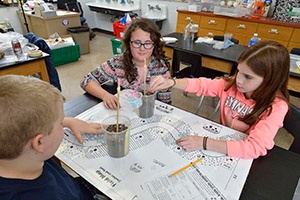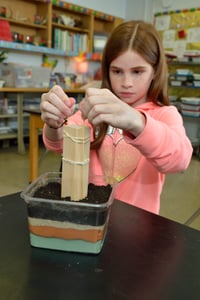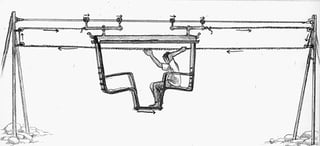Today’s guest blogger is Kate Sokol, a curriculum designer for EiE.
 As a curriculum writer for Engineering is Elementary, I’m always thinking about developing activities that promote engineering habits of mind. Many habits of mind; like “collaboration,” “communication,” and “creativity”; naturally integrate with the type of hands-on engineering activities that we develop, and are often used to describe the work of engineers. Other habits, like the call for “ethical considerations,” require deliberate reflection to fully integrate into the K-8 classroom. The idea of ethics in engineering may seem like a daunting topic to navigate with students, but the power of critical thinking and the opportunity for students to consider the impact of their decisions has never been more important.
As a curriculum writer for Engineering is Elementary, I’m always thinking about developing activities that promote engineering habits of mind. Many habits of mind; like “collaboration,” “communication,” and “creativity”; naturally integrate with the type of hands-on engineering activities that we develop, and are often used to describe the work of engineers. Other habits, like the call for “ethical considerations,” require deliberate reflection to fully integrate into the K-8 classroom. The idea of ethics in engineering may seem like a daunting topic to navigate with students, but the power of critical thinking and the opportunity for students to consider the impact of their decisions has never been more important.
A Conversation Worth Having
 Ethical implications in engineering, as defined by Engineering in K-12 Education, refers to the “impacts of engineering on people and the environment; ethical considerations include possible unintended consequences of a technology, the potential disproportionate advantages or disadvantages of a technology for certain groups or individuals, and other issues” related to social justice. In other words, ethics is a component of engineering that requires students to reflect upon the complicated nature of their design decisions and the effect of their technology on the wider world. Conversations about tradeoffs in engineering, including impacts on society and the environment, can push kids’ thinking in all sorts of remarkable interdisciplinary directions, and are certainly worth having with your kids.
Ethical implications in engineering, as defined by Engineering in K-12 Education, refers to the “impacts of engineering on people and the environment; ethical considerations include possible unintended consequences of a technology, the potential disproportionate advantages or disadvantages of a technology for certain groups or individuals, and other issues” related to social justice. In other words, ethics is a component of engineering that requires students to reflect upon the complicated nature of their design decisions and the effect of their technology on the wider world. Conversations about tradeoffs in engineering, including impacts on society and the environment, can push kids’ thinking in all sorts of remarkable interdisciplinary directions, and are certainly worth having with your kids.
Making Tough Choices
For example, in the unit A Stick in the Mud: Evaluating a Landscape, the engineering design challenge—siting a TarPul, a type of bridge  that uses cables to pull passengers across its span (shown at right)—is presented in a context where many points of view come together around the Karnali River in Nepal. Students are asked to choose the best site for the TarPul based on their combined understanding of the region’s geology, river curvature and flooding, TarPul construction, and the cultural knowledge of village elders. This situation presents a very real-world problem for engineers working in and outside of the classroom. They often must find a compromise between where the villagers (the client) want the bridge to be and the most practical design as dictated by the geology. In this design challenge, the villagers may be less likely to use the TarPul if it is not in the desired location, but students must also take the villagers’ safety and the structural integrity of the TarPul into consideration. In order to make the best recommendations to the village elders, students must utilize all of the information they gleaned from their experiences throughout this unit. They must think about their engineering work alongside the specific needs and values of the people their technology is intended to serve. As we designed it, there is no one optimal solution; each proposed location has strengths and weaknesses that must be weighed (the video below shows kids exploring their choices together). Of course in real life, the stakes for vulnerable communities are often much higher. This challenge offers students a brief glimpse into the complicated tradeoffs that real engineers must consider when thinking about the impacts of their designs.
that uses cables to pull passengers across its span (shown at right)—is presented in a context where many points of view come together around the Karnali River in Nepal. Students are asked to choose the best site for the TarPul based on their combined understanding of the region’s geology, river curvature and flooding, TarPul construction, and the cultural knowledge of village elders. This situation presents a very real-world problem for engineers working in and outside of the classroom. They often must find a compromise between where the villagers (the client) want the bridge to be and the most practical design as dictated by the geology. In this design challenge, the villagers may be less likely to use the TarPul if it is not in the desired location, but students must also take the villagers’ safety and the structural integrity of the TarPul into consideration. In order to make the best recommendations to the village elders, students must utilize all of the information they gleaned from their experiences throughout this unit. They must think about their engineering work alongside the specific needs and values of the people their technology is intended to serve. As we designed it, there is no one optimal solution; each proposed location has strengths and weaknesses that must be weighed (the video below shows kids exploring their choices together). Of course in real life, the stakes for vulnerable communities are often much higher. This challenge offers students a brief glimpse into the complicated tradeoffs that real engineers must consider when thinking about the impacts of their designs.
People-First Technology
While students grapple with the fact that there is often no perfect solution to a problem and engineers have to find ways to optimize the factors at hand, the “ethical considerations” habit of mind serves as a reminder, an appeal, to design people-first technology. Ursula Franklin; a research physicist, educator, and writer on the political and social effects of technology; writes, “Like democracy, technology is a multifaceted entity. It includes activities as well as a body of knowledge, structures as well as the act of structuring . . . How does one talk about something that is both fish and water, means as well as end?” It’s true that the ethical implications of engineering and technology reveal themselves in the engineering design process, as well as the product. The spirit in which engineering happens, the habits of mind students use to approach it, and the conscience of those who design in this world, all contribute to the great responsibility of choosing what’s right, even if it is sometimes viewed as less practical.
For more on this topic, visit Engineering, Social Justice, and Peace or check out Engineering and Social Justice by Donna Riley.








